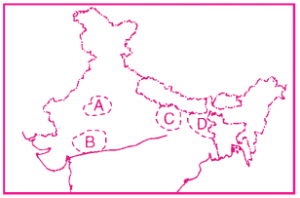(a) 601
(b) 300
(c) 330
(d) 407
UPSC CSE PRE 1997
Which one of the following was a corporation of merchants in ancient India?
(a) Chaturvedimangalam
(b) Parishad
(c) Ashtadikgaja
(d) Manigrama
Match List-I with List-II and select the correct answer using the codes given below the lists:
| List-I (Author) | List-II (Text) |
| A. Varahamihira | 1. Prabandha Chintamani |
| B. Vishakhadatta | 2. Mrichchha-Katikam |
| C. Sudraka | 3. Brihat-Samhita |
| D. Bilhana | 4. Devi-Chandraguptam |
| 5. Vikramankadeva-Charita |
Codes:
(a) A – 3; B – 4; C – 5; D – 2
(b) A – 3; B – 4; C – 2; D – 5
(c) A – 5; B – 3; C – 4; D – 1
(d) A – 1; B – 3; C – 5; D – 2
The silver coins issued by the Guptas were called:
(a) Rupaka
(b) Karshapana
(c) Dinara
(d) Pana
In the Mahayana Buddhism, the Bodhisatva Avalokitesvara was also known as:
(a) Vajrapani
(b) Manjusri
(c) Padmapani
(d) Maitreya
The following map shows four of the sixteen Mahajanapadas that existed in ancient India:

The places marked A, B, C and D respectively are:
(a) Matsya, Cedi, Kosala, Anga
(b) Surasena, Avanti, Vatsa, Magadha
(c) Matsya, Avanti, Vatsa, Anga
(d) Surasena, Cedi, Kosala, Magadha
Which one of the following edicts mentions the personal name of Ashoka?
(a) Kalsi
(b) Rummindei
(c) Special Kalinga Edict
(d) Maski
Milindapanho is in the form of a dialogue between the king Menander and Buddhist monk:
(a) Nagasena
(b) Nagarjuna
(c) Nagabhatta
(d) Kumarilabhatta
The famous dialogue between Nachiketa and Yama is mentioned in the:
(a) Chhandogyopanishad
(b) Mundakopanishad
(c) Kathopanishad
(d) Kenopanishad
Which one of the following scripts of ancient India was written from right to left?
(a) Brahmi
(b) Nandnagari
(c) Sharada
(d) Kharosthi
